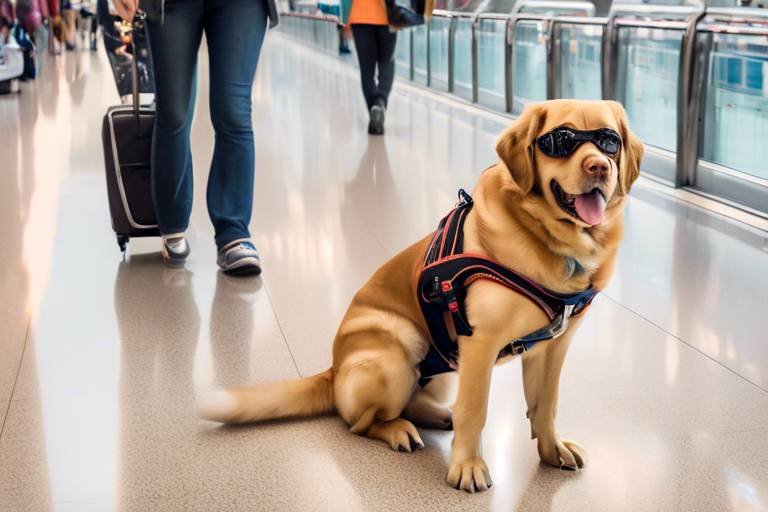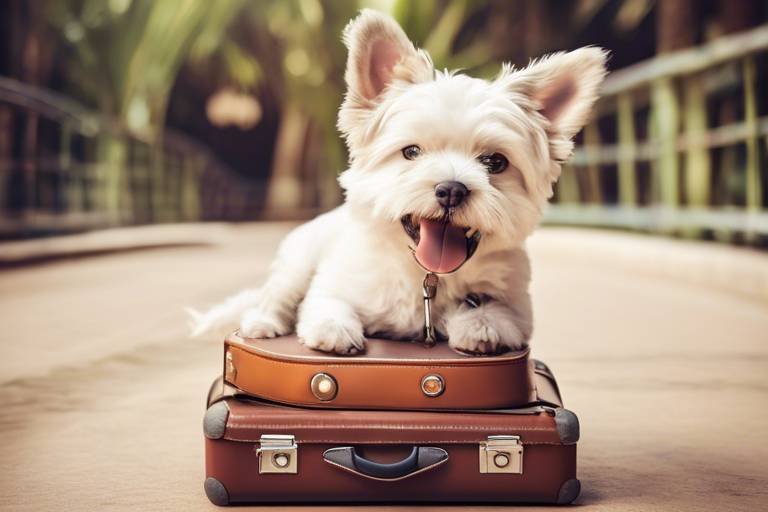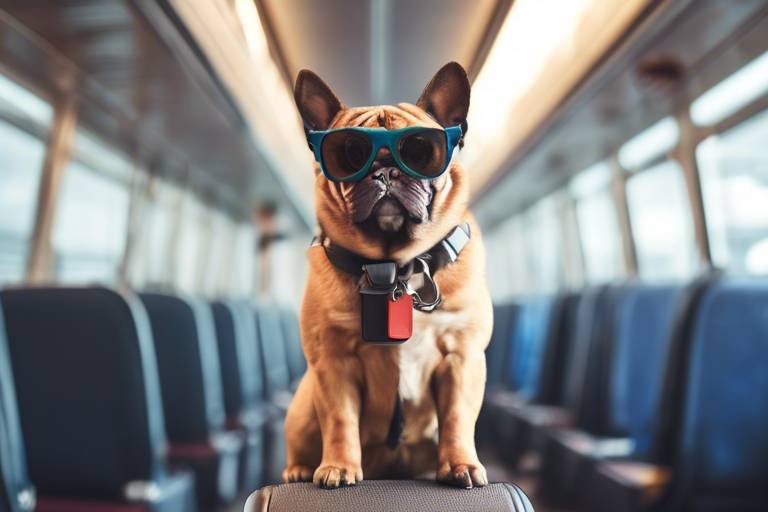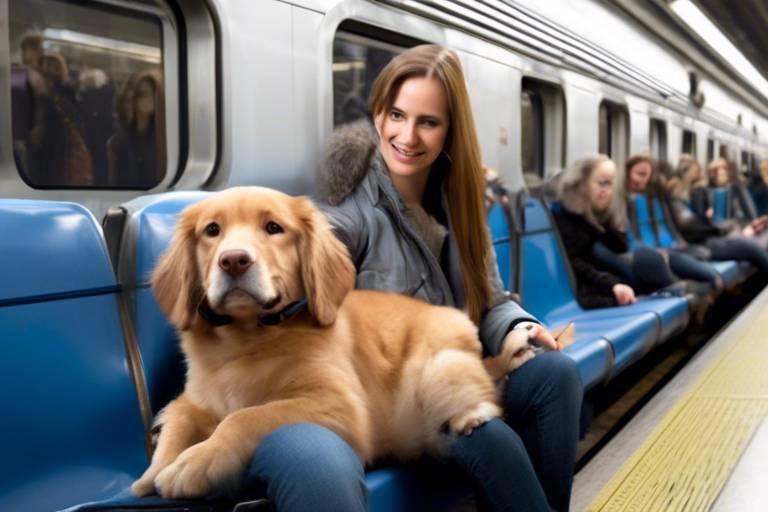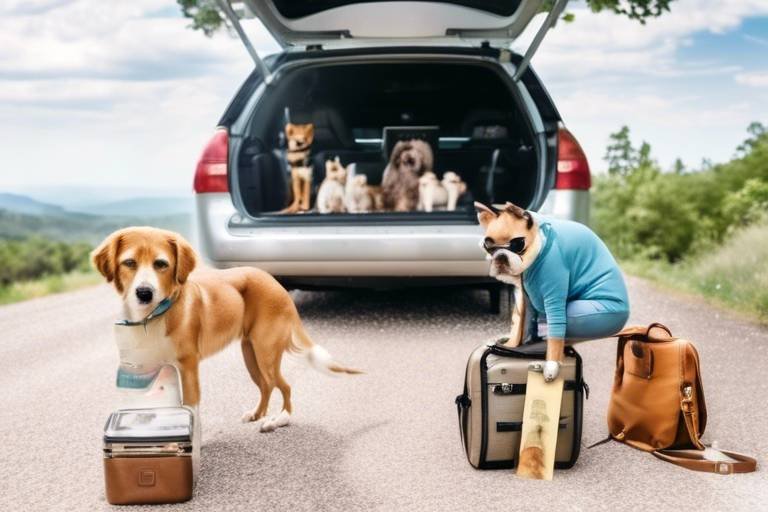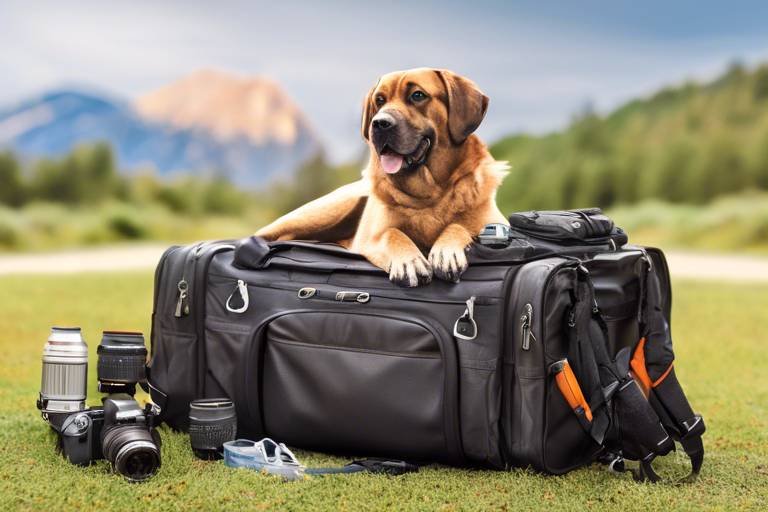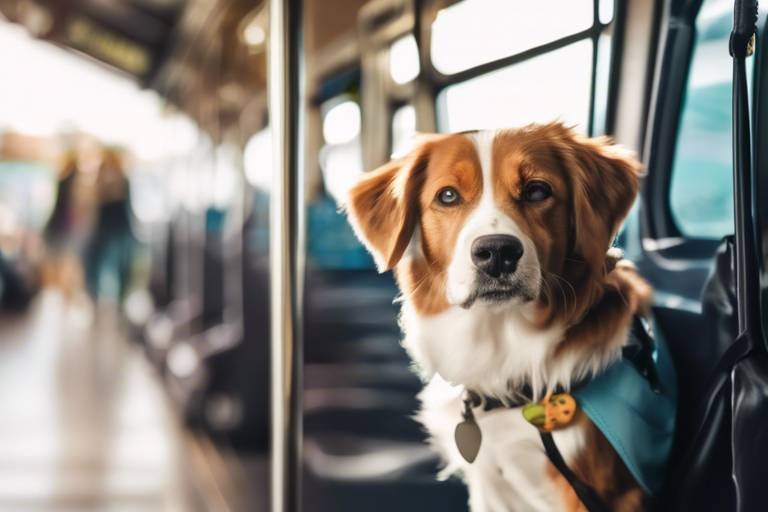The Benefits of Traveling with a Pet Service Dog
Traveling can be one of life's most exhilarating experiences, but it can also come with its fair share of challenges. For those who require assistance due to disabilities, traveling can seem daunting. However, traveling with a service dog can transform these challenges into opportunities for joy and comfort. Imagine embarking on a journey with your furry companion by your side, providing not just companionship but also emotional support and a sense of security. In this article, we will explore the numerous advantages of having a service dog as your travel buddy, including emotional support, enhanced safety, and improved travel experiences for both the owner and their loyal companion.
Traveling can often lead to feelings of anxiety and fear, especially in unfamiliar environments. This is where a service dog shines. Their presence offers a calming influence, helping to alleviate stress and create a sense of security. Think of your service dog as your personal emotional anchor. When the hustle and bustle of an airport or the chaos of a new city begins to overwhelm you, your dog can provide the comfort you need to navigate through it all. They are trained to sense when their owner is feeling anxious and can offer that much-needed reassurance, whether it’s through a gentle nudge or simply being there by your side.
Service dogs are not just companions; they are trained to assist individuals with disabilities, ensuring better accessibility during travel. From navigating busy airports to helping with public transport, service dogs make traveling easier and more enjoyable. They can guide their owners through crowded spaces, alert them to important sounds, and even assist with tasks like opening doors or retrieving items. This level of assistance allows travelers to focus on enjoying their journey rather than worrying about potential obstacles.
Understanding air travel regulations regarding service dogs is crucial for a smooth journey. Airlines have specific policies that can vary significantly from one carrier to another. Being informed about these regulations can save you from complications during check-in and boarding. For example, some airlines may require advance notice or specific documentation to ensure your service dog can accompany you in the cabin. By doing your homework ahead of time, you can prevent any last-minute surprises that could derail your travel plans.
Travelers may need to provide documentation verifying their dog's service status. Knowing what paperwork is required can streamline the boarding process and avoid potential issues. Most airlines will ask for a letter from a licensed mental health professional or a doctor that confirms the need for a service dog. It’s always a good idea to carry this documentation with you, along with any vaccination records, to ensure you’re prepared for any questions that may arise.
Not all airlines have the same policies regarding service dogs. Researching and selecting an airline that accommodates service animals can enhance the travel experience significantly. Look for airlines that are known for their pet-friendly policies and have a good track record of accommodating passengers with service animals. This can make your journey much smoother and more enjoyable.
When traveling with a service dog, knowing public space etiquette is essential. Understanding how to behave in various settings ensures a respectful and enjoyable experience for everyone involved. For instance, while it’s natural to want to show off your amazing companion, it’s important to remember that service dogs are working animals. Avoid distracting them while they are on duty, and educate others on how to interact appropriately. This not only helps maintain the focus and effectiveness of the service dog but also fosters a respectful environment for all travelers.
Traveling with a service dog requires attention to health and safety. Ensuring the dog is well-trained, vaccinated, and comfortable can prevent health issues during the journey. Just like humans, service dogs can be susceptible to stress and illness while traveling. Make sure they are well-rested and familiar with their travel environment. Carrying a travel kit that includes essential items such as food, water, and first-aid supplies can also ensure their well-being throughout the journey.
Regular veterinary check-ups are vital for maintaining a service dog's health. Keeping vaccinations up-to-date and monitoring for any potential health concerns is essential before traveling. Just as you would prepare yourself for a trip, preparing your service dog is equally important. A quick visit to the vet can help identify any issues that could arise during travel, ensuring a smooth experience for both of you.
Being prepared for emergencies while traveling with a service dog is crucial. Having a plan in place ensures both the owner and their dog can handle unexpected situations effectively. This could mean knowing where the nearest veterinary clinic is located or having a list of emergency contacts. It’s always better to be over-prepared than caught off guard.
Traveling with a service dog can enhance the overall experience. Their presence often leads to increased social interactions and positive encounters with others, enriching the journey for both the owner and the dog. People are often drawn to service dogs, leading to conversations that can turn a mundane travel day into a memorable experience. Whether it’s a friendly chat with a fellow traveler or a kind word from a stranger, these interactions can make your journey feel more connected and less isolating.
- Can any dog be a service dog? No, only dogs that have been specifically trained to perform tasks for individuals with disabilities can be classified as service dogs.
- Are there breed restrictions for service dogs? While some airlines or establishments may have breed restrictions, service dogs are protected under the Americans with Disabilities Act (ADA) regardless of breed.
- What tasks can a service dog perform? Service dogs can perform a variety of tasks, including guiding individuals with visual impairments, alerting those with hearing impairments, and providing emotional support for anxiety or PTSD.

Emotional Support and Comfort
Traveling can often feel like a daunting task, filled with uncertainties and the potential for stress. But imagine having a furry companion by your side, one that is not only loyal but also trained to provide emotional support. A service dog can be a game changer, transforming the way you experience travel. Their mere presence can serve as a comforting anchor amidst the chaos of unfamiliar places, long lines, and crowded spaces. It’s like having a warm blanket wrapped around you, making the world feel just a little bit safer.
Picture this: you’re at a bustling airport, surrounded by strangers and the constant hum of announcements. Anxiety begins to creep in, but then you look down and see your service dog, patiently sitting by your side, their calm demeanor radiating peace. This bond creates a sense of security that is hard to replicate. For many individuals, especially those with anxiety or PTSD, a service dog can help alleviate feelings of panic and fear. They act as a buffer, providing a sense of normalcy and grounding in a chaotic environment.
Moreover, service dogs are trained to recognize signs of distress in their owners. They can nudge, lick, or even lay across your lap when they sense that you’re feeling overwhelmed, reminding you that you’re not alone. This emotional connection can be incredibly powerful, helping to reduce stress levels and improve overall well-being. Just as a trusted friend would offer a reassuring word or a comforting touch, a service dog provides unconditional support, making every journey feel more manageable.
In addition to emotional support, traveling with a service dog can also foster social interactions. People are naturally drawn to dogs, and having your furry friend with you can open up conversations with fellow travelers. Whether it’s someone asking about your dog’s training or sharing their own pet stories, these interactions can enhance your travel experience. It’s like having a social icebreaker that not only helps you connect with others but also distracts from the stresses of travel.
Ultimately, the emotional support and comfort provided by a service dog can turn a potentially overwhelming experience into a more enjoyable adventure. They are not just pets; they are partners that help navigate the emotional landscape of travel, ensuring that you can focus on the journey ahead rather than the hurdles along the way. So, when considering your next trip, think about how a service dog could transform your travel experience into something truly enriching.
- What is the difference between a service dog and an emotional support dog? Service dogs are trained to perform specific tasks for individuals with disabilities, while emotional support dogs provide comfort but are not trained to perform tasks.
- Can I take my service dog everywhere? While service dogs are allowed in most public places, there may be restrictions in certain areas, so it's always best to check ahead.
- Do I need documentation for my service dog when traveling? Yes, having proper documentation can help streamline the boarding process, especially with airlines.

Improved Accessibility
Traveling can sometimes feel like navigating a maze, especially when you have a disability. That's where a service dog comes into play, acting as a loyal companion and a helpful guide. These incredible animals are not just pets; they are trained to assist individuals with disabilities, making travel not only possible but also enjoyable. Imagine walking through a bustling airport, surrounded by a sea of people and noise. With a service dog by your side, you can feel a sense of confidence and security that is hard to achieve alone.
Service dogs are specifically trained to help their owners in various ways, ensuring that you can navigate through crowded places, board public transport, and access facilities with ease. For instance, they can help you find elevators, alert you to important announcements, and even assist in carrying your belongings. This level of support is invaluable, particularly when you're in an unfamiliar environment. The presence of a service dog can transform a potentially overwhelming experience into a more manageable one.
Moreover, the accessibility that service dogs provide extends beyond just physical navigation. They can also help break down social barriers. People are often more willing to engage and offer assistance when they see a service dog. Their presence can spark conversations and create connections, making it easier for you to interact with others during your travels. It's like having a social icebreaker that comes with a wagging tail!
However, it's important to be aware of the specific regulations and policies that govern the use of service dogs in different travel settings. For example, airports and airlines have their own rules regarding service animals, which can vary significantly. Understanding these regulations can help you avoid any last-minute surprises that could hinder your travel plans.
In addition to navigating through transportation hubs, service dogs can assist in accessing various public spaces. Whether you're visiting a museum, dining at a restaurant, or exploring a new city, having a service dog can make these experiences more accessible. They can help guide you through crowds, alert you to potential hazards, and even assist in finding accessible restrooms.
Ultimately, the improved accessibility that comes with traveling with a service dog not only enhances your travel experience but also fosters a greater sense of independence. With their help, you can explore new places, meet new people, and create lasting memories without the constant worry of navigating obstacles alone. So, whether you're planning a weekend getaway or a cross-country adventure, consider the incredible benefits that a service dog can bring to your journey.
| Question | Answer |
|---|---|
| What types of disabilities can a service dog assist with? | Service dogs can assist individuals with a variety of disabilities, including physical mobility issues, visual impairments, hearing impairments, and mental health conditions such as PTSD. |
| Are there any restrictions on where service dogs are allowed? | Service dogs are generally allowed in all public places, including restaurants, stores, and public transportation. However, specific regulations may vary by location. |
| Do I need special documentation for my service dog when traveling? | Yes, it’s advisable to have documentation that verifies your dog’s service status, especially when traveling by air. This can help ensure a smooth boarding process. |
Air Travel Regulations
When it comes to air travel with a service dog, understanding the regulations is crucial for ensuring a smooth journey. Different airlines have varying policies regarding service animals, so it's essential to do your homework before booking your flight. Most airlines require that service dogs be trained to perform specific tasks that assist their owners with disabilities. This means that simply having a pet dog won't qualify; your canine companion needs to be recognized as a service animal under the law.
Before you embark on your adventure, familiarize yourself with the documentation requirements. Airlines typically ask for proof of your dog's service status, which may include a letter from a healthcare provider or an identification card that clearly states your dog's role as a service animal. Having these documents ready can save you from potential headaches at the airport. It's also wise to check if the airline has any specific forms that need to be filled out prior to your flight.
Here's a quick breakdown of what you should keep in mind:
- Service Animal Definition: Ensure your dog meets the legal definition of a service animal, which is typically a dog trained to perform tasks for individuals with disabilities.
- Documentation: Be prepared to present necessary documentation, such as a letter from a physician or identification proving your dog's status.
- Airline Policies: Research the specific policies of the airline you are flying with, as they can differ significantly.
Moreover, it’s essential to arrive at the airport early. Security checks may take longer when traveling with a service dog, as you'll need to go through additional screening processes. Be patient and allow extra time for these procedures. Once you’re at the gate, don’t hesitate to speak to the airline staff about any concerns or questions you may have regarding your service dog. They are trained to assist you and can provide valuable information to ease your travel experience.
In summary, being well-informed about air travel regulations regarding service dogs can make a world of difference in your travel experience. By preparing in advance, you can ensure that both you and your furry companion have a hassle-free journey, allowing you to focus on what truly matters: enjoying your travels together!
- What documentation do I need to travel with a service dog?
Most airlines require a letter from a healthcare provider and may have specific forms to fill out. - Can any dog be considered a service dog?
No, only dogs that are specifically trained to assist individuals with disabilities qualify as service animals. - What should I do if my airline does not allow my service dog?
Research and choose an airline with policies that accommodate service animals.
Documentation Requirements
When it comes to traveling with a service dog, understanding the is essential for a smooth journey. Different airlines and travel companies may have varying policies, so it's crucial to be prepared. Generally, you will need to provide proof that your dog is a certified service animal. This documentation typically includes:
- Service Animal Certification: A letter or certificate from a licensed professional confirming that your dog is trained to assist you with your specific disability.
- Vaccination Records: Up-to-date vaccination records are often required to ensure the health and safety of all passengers.
- Identification Tags: While not always mandatory, having a tag that identifies your dog as a service animal can be helpful.
It's also a good idea to carry a copy of your dog's training credentials, as this can help clarify any questions that may arise during travel. Each airline will have its own set of rules regarding service dogs, so checking their specific requirements ahead of time can save you a lot of hassle. For example, some airlines may require that you submit your documentation at least 48 hours before your flight, while others may ask for it at the time of check-in.
Furthermore, if you're traveling internationally, be aware that other countries might have different regulations regarding service animals. Researching the destination's requirements will help you avoid any last-minute surprises. Always keep your documentation organized and easily accessible, as this can make the boarding process smoother.
In summary, being well-prepared with the necessary documentation not only ensures compliance with airline regulations but also provides peace of mind, allowing you to focus on enjoying your travel experience with your beloved service dog.
1. Do I need to register my service dog to travel?
No, you do not need to register your service dog; however, having documentation that proves their training and status can be beneficial.
2. Can I travel with my emotional support animal?
Emotional support animals do not have the same rights as service dogs under the ADA. Check with your airline for their specific policies regarding emotional support animals.
3. What should I do if my service dog is denied boarding?
If your service dog is denied boarding, ask for a clear explanation of the reason. You may need to provide additional documentation or speak with a supervisor.
4. Are there any restrictions on the size or breed of service dogs?
Generally, there are no size or breed restrictions for service dogs, but they must be well-behaved and able to perform their duties without causing disruption.
Choosing the Right Airline
When it comes to traveling with your service dog, can make all the difference in your journey. Not all airlines have the same policies or accommodations for service animals, and understanding these differences is key to a smooth travel experience. Imagine stepping into an airport, your heart racing with excitement, but then feeling the weight of uncertainty as you navigate the rules of each airline. Wouldn't it be great to avoid that stress?
First off, it’s essential to do your homework. Start by visiting the websites of various airlines to review their specific service dog policies. Most airlines will outline their requirements clearly. Here are some crucial aspects to consider:
- Documentation: Some airlines require specific documentation to verify that your dog is a service animal. This could include a letter from a licensed professional or a certification of training. Knowing this in advance can save you from last-minute scrambles.
- Fees: While many airlines do not charge for service dogs, some may have additional fees for larger dogs or certain travel classes. Being informed can help you budget accordingly.
- Seating Arrangements: Different airlines have different policies regarding where service dogs can sit. Some may allow your dog to sit at your feet, while others may require them to be in a designated area. Understanding these policies can help you prepare for a comfortable journey.
Furthermore, consider the airline's reputation for handling service animals. Do they have a history of accommodating passengers with disabilities? Reading reviews from other travelers can provide insight into their experiences. Look for comments on how the airline staff treated their service dogs and whether they felt supported throughout their journey.
Another factor to consider is the flight duration. Longer flights can be challenging for both you and your service dog. If possible, choose airlines that offer direct flights to minimize the stress of layovers and transfers. A direct flight can significantly reduce the chances of encountering unexpected issues, allowing for a more pleasant experience.
Finally, don't hesitate to reach out to customer service representatives before booking your flight. Ask any questions you may have about their service dog policies, and don’t shy away from expressing your concerns. A friendly and knowledgeable representative can provide reassurance and help you feel more prepared for your trip.
In summary, taking the time to research and choose the right airline can transform your travel experience with your service dog from a potential headache into a smooth adventure. With the right preparation, you can focus on what truly matters: making memories with your furry companion.
- What documentation do I need to travel with a service dog? Most airlines require a letter from a licensed professional stating that you need a service dog for your disability.
- Are there fees associated with flying with a service dog? Generally, airlines do not charge fees for service dogs, but it's best to check with the specific airline.
- Can my service dog sit on my lap during the flight? Policies vary by airline; some allow this while others require service dogs to sit on the floor at your feet.
Public Space Etiquette
When traveling with a service dog, understanding is essential for creating a harmonious experience for everyone involved. Imagine you're in a bustling airport or a crowded park; the last thing you want is for your furry companion to inadvertently cause a disruption. Service dogs are trained to behave appropriately in public, but as their handlers, it’s crucial to set the right example. This means being aware of your surroundings, respecting personal space, and ensuring that your service dog is well-behaved and focused on their tasks.
One of the key aspects of public space etiquette is keeping your service dog close and well-controlled. This not only helps in preventing any potential accidents but also reassures those around you that your dog is trained and reliable. When navigating through crowded areas, it’s best to keep your dog on a short leash. This way, you can easily guide them and avoid any unwanted interactions with other people or animals. Remember, not everyone understands the role of a service dog, and some may not be comfortable around dogs, regardless of their training.
Additionally, it’s important to avoid distractions for your service dog. They are trained to assist you, and any noise, food, or other distractions can divert their attention from their duties. If you're in a situation where food is present, ensure that your dog is not tempted to beg or scavenge. This is not just a matter of etiquette; it’s about maintaining the integrity of their training. If your dog is focused and calm, it reflects positively on you as their handler, showcasing the bond and trust between you and your service animal.
Another aspect of public space etiquette is being mindful of other people's comfort. If someone approaches you to ask about your service dog, it's perfectly acceptable to share that your dog is a trained service animal. However, remember that you are not obligated to disclose personal information regarding your disability. A polite, brief explanation is usually sufficient. If someone seems uncomfortable or expresses a desire to interact with your dog, gauge the situation. While many people may want to pet or play with your service dog, it’s important to prioritize your dog's focus and tasks over social interactions.
To summarize, here are some key points to keep in mind regarding public space etiquette when traveling with a service dog:
- Keep your service dog close and on a short leash.
- Avoid distractions that could divert your dog's attention.
- Be respectful of others' space and comfort levels.
- Respond politely to inquiries about your service dog without oversharing personal details.
By adhering to these guidelines, you not only enhance your own travel experience but also contribute to a greater understanding and acceptance of service animals in public spaces. The more we demonstrate proper etiquette, the more likely it is that others will recognize the important role service dogs play in the lives of their handlers.
What should I do if someone tries to pet my service dog?
It's essential to politely inform them that your service dog is working and should not be distracted. You can explain that interacting with the dog could interfere with their duties.
Can I take my service dog to any public place?
Generally, service dogs are allowed in any public space where the public is permitted. However, it's always wise to check specific rules for certain venues, such as restaurants or theaters.
What if my service dog misbehaves in public?
If your service dog misbehaves, it may be a sign that they need more training or that the environment is too overwhelming. It's important to address any behavioral issues with a professional trainer.
Do I need to provide documentation for my service dog?
While you are not required to carry documentation for your service dog, having it on hand can be helpful in certain situations, especially when traveling.

Health and Safety Considerations
Traveling with a service dog is not just about the joy of companionship; it also comes with a set of health and safety considerations that every owner must keep in mind. Just like any other family member, your service dog deserves the best care while you travel. This means ensuring that they are not only well-trained but also in optimal health before embarking on your journey. Imagine planning a dream vacation, only to be faced with health issues that could have been prevented with a little foresight. That's why it's essential to prioritize your furry friend's well-being.
One of the first steps in preparing for travel is to schedule regular veterinary check-ups. These visits are crucial for maintaining your service dog's health and ensuring they are up-to-date on vaccinations and treatments. A healthy dog is a happy dog, and a happy dog makes for a much smoother travel experience. Keeping track of their health records can also be beneficial in case you need to provide documentation during your travels.
Furthermore, it's important to consider potential health issues that could arise while on the road. For instance, changes in climate or environment can affect your dog's health. If you're traveling to a hotter destination, make sure your service dog is acclimatized and has access to plenty of water. Also, be mindful of their diet; sudden changes in food can lead to digestive issues. To help you keep track, here’s a quick table that outlines some common health considerations:
| Health Consideration | Description |
|---|---|
| Vaccinations | Ensure all vaccinations are up-to-date before traveling. |
| Diet | Maintain a consistent diet to avoid digestive problems. |
| Hydration | Always have fresh water available, especially in hot climates. |
| Emergency Contacts | Have contact information for local veterinarians at your destination. |
In addition to health checks, being prepared for emergencies while traveling with a service dog is crucial. Emergencies can happen at any time, whether it's a sudden illness, an injury, or even a lost dog. Having a plan in place can make all the difference. For instance, carry a first aid kit specifically designed for dogs, which should include items like antiseptic wipes, gauze, and any medications your dog might need. Knowing how to respond to common emergencies can save your dog's life and give you peace of mind while traveling.
Lastly, don’t forget to pack your service dog’s essentials, including their food, water, leash, and any comfort items that can help them feel at home in unfamiliar surroundings. Just like you wouldn’t leave home without your favorite blanket or pillow, your service dog will appreciate having their own familiar items. After all, a little bit of comfort can go a long way in making travel less stressful for both of you.
- What should I do if my service dog gets sick while traveling?
Seek immediate veterinary care and keep a list of local veterinarians handy.
- How can I keep my service dog calm during travel?
Bring familiar items, maintain their routine, and ensure they have regular breaks.
- Are there specific health documents I need to carry?
Yes, keep vaccination records and any necessary health certificates with you.
Regular Veterinary Check-ups
When it comes to traveling with a service dog, are not just a good idea; they are essential. Just like us, our furry companions need routine health assessments to ensure they are fit and ready for the adventures that lie ahead. Imagine planning a trip to a beautiful beach or a bustling city, only to find out that your service dog is unwell. That’s a scenario no pet owner wants to face!
During these check-ups, veterinarians can identify any underlying health issues before they become serious problems. This proactive approach not only keeps your dog healthy but also provides peace of mind for you as a traveler. It's crucial to ensure that your service dog is up-to-date on vaccinations, as many places, including hotels and parks, require proof of vaccination for entry. Not to mention, keeping your dog healthy means you can focus on enjoying your trip rather than worrying about their well-being.
Here are some key aspects to consider during your veterinary visits:
- Vaccination Status: Make sure your service dog is current on all vaccinations. This is particularly important when traveling to different regions, as some areas may have specific health risks.
- Weight Management: Keeping your dog at a healthy weight is vital for their overall health and mobility, especially during travel when they may not get as much exercise.
- Behavioral Assessments: Discuss any behavioral concerns with your vet. A calm and well-behaved service dog is critical for a smooth travel experience.
Additionally, it’s a good practice to have a travel health record for your service dog. This document should include vaccination details, any medications your dog may need, and a summary of their health history. Having this information on hand can be invaluable if you need to visit a vet while traveling. It’s like having a safety net that ensures your dog’s health is always a priority, no matter where your adventures take you!
In summary, regular veterinary check-ups are a cornerstone of responsible pet ownership, especially for those who travel with a service dog. By keeping your dog healthy, you are not only enhancing their quality of life but also enriching your travel experiences together. So, before you hit the road or take to the skies, make that appointment with your vet. Your furry friend will thank you for it!
- How often should I take my service dog for check-ups? It is generally recommended to have a veterinary check-up at least once a year. However, older dogs or those with health issues may require more frequent visits.
- What should I bring to the vet for my service dog? Bring any previous health records, vaccination documentation, and a list of any medications your dog is taking.
- Can I travel with my service dog if they have health issues? It depends on the severity of the health issue. Always consult with your veterinarian before making travel plans.
Emergency Preparedness
When you're on the road with your service dog, being prepared for emergencies is not just a good idea; it's essential. Imagine you're in a bustling city, and suddenly your furry companion has a health scare or gets lost. The thought alone can send shivers down your spine, right? But with a solid emergency plan in place, you can turn that anxiety into confidence. It’s all about being proactive rather than reactive.
First things first, make sure you have a first-aid kit specifically tailored for your service dog. This kit should include essential items like bandages, antiseptic wipes, and any medications your dog may need. You wouldn’t want to be scrambling for supplies when time is of the essence. Additionally, familiarize yourself with basic first-aid procedures for dogs; knowing how to handle minor injuries can make a huge difference.
Another critical aspect of emergency preparedness is having a list of veterinary clinics and pet-friendly hospitals in the areas you plan to visit. This way, if an emergency arises, you won’t be left searching for help. You can create a simple table to keep this information organized:
| Location | Veterinary Clinic Name | Contact Number |
|---|---|---|
| City A | Vet Clinic A | (123) 456-7890 |
| City B | Vet Clinic B | (098) 765-4321 |
| City C | Vet Clinic C | (555) 123-4567 |
In addition to having a first-aid kit and a list of veterinary clinics, make sure your dog is wearing a collar with an ID tag that includes your contact information. This is crucial if your dog were to get lost in an unfamiliar place. You might also consider microchipping your dog as an extra layer of security.
Finally, prepare for the unexpected by having a backup plan. This could mean identifying pet-friendly accommodations or knowing the nearest dog-friendly parks where you can take your service dog for a walk. The more prepared you are, the less stressed you’ll feel, and that calmness will undoubtedly transfer to your canine companion.
- What should I include in my service dog's emergency kit? Your kit should contain bandages, antiseptic wipes, any medications your dog may need, and a basic first-aid manual for pets.
- How can I find a vet in an unfamiliar area? Research veterinary clinics in advance and keep a list handy. You can also use apps that locate nearby veterinary services.
- Is microchipping my service dog necessary? While not mandatory, microchipping provides an extra layer of security if your dog gets lost.
- What if my service dog becomes ill while traveling? Contact a local vet immediately and follow your emergency plan to ensure your dog's health and safety.
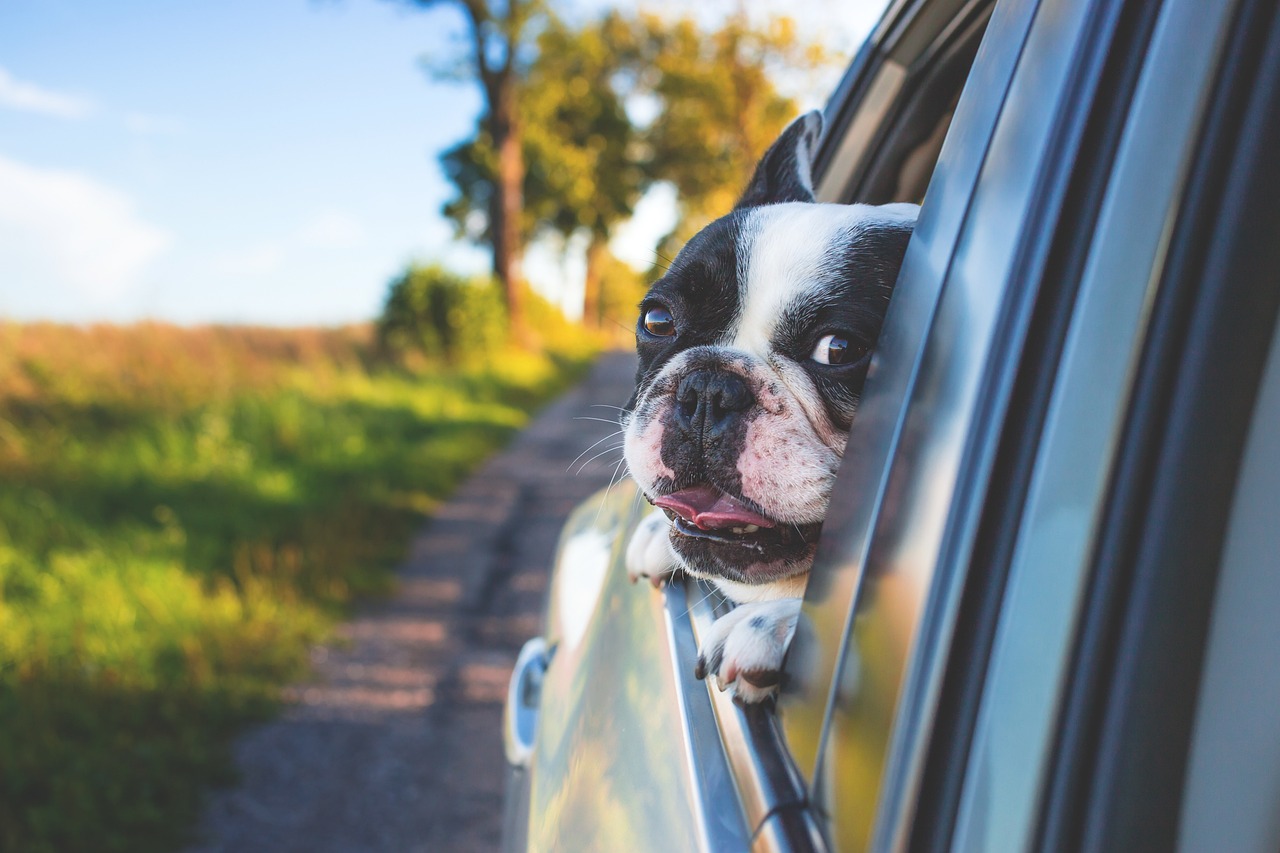
Enhancing Travel Experiences
Traveling is not just about reaching a destination; it's about the experiences we gather along the way. When you bring your service dog with you, those experiences can become even more enriching. Imagine strolling through a bustling city with your furry companion by your side, turning heads and sparking conversations. The presence of a service dog can act as a social catalyst, breaking the ice with fellow travelers and locals alike. People are often drawn to dogs, and having a service dog can lead to unexpected friendships and delightful interactions.
Moreover, the companionship of a service dog can transform mundane travel moments into memorable adventures. Whether you're waiting in a long airport line or sitting in a crowded café, your dog’s calming influence can help ease your nerves. Their presence can make you feel more at ease, allowing you to soak in the atmosphere around you rather than feeling overwhelmed. It's like having a built-in support system that not only enhances your travel experience but also encourages you to explore new places with confidence.
Additionally, traveling with a service dog can open up a variety of opportunities that you might not have considered. Many hotels, restaurants, and attractions are becoming increasingly pet-friendly, which means you can enjoy more options when planning your trips. For instance, some establishments offer special amenities for guests traveling with service animals, such as designated pet areas or pet-friendly menus. This not only enhances your travel experience but also ensures that your dog feels comfortable and included in your adventures.
It's also important to note how service dogs can help you navigate different environments. Their training allows them to assist in various situations, from alerting you to potential dangers to providing stability in crowded places. This means you can explore bustling markets, busy tourist attractions, or even serene nature trails with greater ease and safety. The bond you share with your service dog can turn every outing into a shared experience, amplifying the joy of discovering new places together.
In conclusion, traveling with a service dog can significantly enhance your overall travel experience. From fostering social connections to providing emotional support and improving accessibility, the benefits are plentiful. Your service dog is not just a companion; they are an integral part of your journey that can transform the ordinary into the extraordinary. So, as you plan your next adventure, consider how your loyal friend can enrich the experience, making every moment more enjoyable.
- Can I take my service dog everywhere? - While service dogs are allowed in many public places, some areas may have restrictions. It's essential to check local regulations.
- What should I do if my service dog misbehaves during travel? - It's crucial to train your service dog thoroughly. If issues arise, try to remove them from the situation and address the behavior calmly.
- Are there any additional costs for traveling with a service dog? - Most airlines and accommodations do not charge extra fees for service dogs, but it's wise to confirm their policies beforehand.
Frequently Asked Questions
- What are the benefits of traveling with a service dog?
Traveling with a service dog offers numerous benefits, including emotional support, enhanced safety, and improved accessibility. These dogs provide comfort during stressful travel situations, making it easier to navigate unfamiliar environments.
- How can a service dog help with anxiety during travel?
Service dogs are trained to sense their owner's anxiety and provide calming support. Their presence can create a sense of security, helping to alleviate fears associated with travel, whether it's in crowded airports or during long flights.
- What documentation is required for traveling with a service dog?
Travelers may need to present documentation that verifies their dog's status as a service animal. This can include a letter from a healthcare professional or proof of training. It's essential to check the specific requirements of the airline or transportation service.
- Are there specific airline policies for service dogs?
Yes, different airlines have varying policies regarding service dogs. It's crucial to research and choose an airline that accommodates service animals to ensure a smooth travel experience. Always check their guidelines before booking your flight.
- How can I prepare my service dog for air travel?
Preparing your service dog for air travel includes ensuring they are well-trained, comfortable in a crate if required, and up-to-date on vaccinations. It's also helpful to take them on shorter trips to acclimate them to the traveling experience.
- What should I do in case of an emergency while traveling?
Having an emergency plan is vital. This includes knowing the location of nearby veterinary clinics, carrying a first aid kit, and having a list of emergency contacts. Being prepared can make a significant difference in unexpected situations.
- How can a service dog enhance social interactions while traveling?
Service dogs often attract positive attention and can serve as conversation starters. Their presence can lead to increased social interactions, making travel more enjoyable for both the owner and their furry companion.
- What health considerations should I keep in mind when traveling with my service dog?
It's essential to ensure your service dog is healthy and comfortable before traveling. Regular veterinary check-ups, up-to-date vaccinations, and monitoring for any health issues are crucial to ensure a safe journey.

